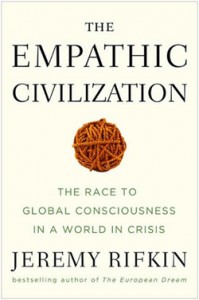 At a recent talk at the Royal Society of the Arts in London, the American economist and social critic Jeremy Rifkin gave a brilliant overview of his new book, The Empathic Civilization. Part of his argument that we should think about ourselves as Homo empathicus – empathic by nature – rests on some of the recent research in neuroscience that appears to demonstrate we have empathic brains. But what is the science really telling us?
At a recent talk at the Royal Society of the Arts in London, the American economist and social critic Jeremy Rifkin gave a brilliant overview of his new book, The Empathic Civilization. Part of his argument that we should think about ourselves as Homo empathicus – empathic by nature – rests on some of the recent research in neuroscience that appears to demonstrate we have empathic brains. But what is the science really telling us?
Rifkin highlights the mysterious entities known as ‘mirror neurons’, which were first discovered in macaque monkeys by Italian researchers in the early 1990s. These are neurons that fire up both when we experience something (such as pain) and also when we see somebody else going through the same experience. People with lots of mirror cells tend to be more empathic, especially in terms of sharing emotions. According to Giacomo Rizzolatti, one of the researchers, ‘mirror neurons allow us to grasp the minds of others not through conceptual reasoning but through direct simulation’. Rifkin’s conclusion is that, ‘we are soft-wired not for aggression, violence, self-interest and utilitarianism’ but rather ‘for sociability, attachment, affection and companionship’. In other words, we are Homo Empathicus.
The RSA have created a superb animated version of Rifkin’s talk, which begins with his summary of the mirror neuron research, complete with drawings of monkeys. You can watch it here:
What Rifkin doesn’t mention is some of the other research which muddies the picture about the empathic brain. For instance, neuroscientists at the University of Washington have identified core brain areas that seem to be responsible for perspective-taking empathy, which has been shown to stimulate activity in areas known as the posterior cingulate/precuneus and the right temporo-parietal junction. In practice this means, for example, that one part of the brain is active when we think about getting one of our fingers pinched in a door, but different parts of the brain – the empathic spots – are switched on when we think about the same thing happening to another person. This all sounds rather different from mirror neurons.
Other research is based on cases of brain injury. In his book, Into the Silent Land: Travels in Neuropsychology, Paul Broks describes a man whose left frontal lobe was damaged in a motorway accident and suffered from a complete loss of his ability to empathise. Following the crash he would regularly say to his wife, in a matter-of-fact way, ‘I don’t love you any more, do I, love?’
Neither of these instances of neurological research into empathy necessarily contradicts the mirror neuron story. But I simply wish to urge caution about how confident we should be with our conclusions. MRI scanners and other new technologies have shown us that empathy is happening in our brains in complex ways. Yet at this stage we have little idea about how it all really functions and links to everyday behaviour. We are like the early astronomers who were able to see new stars with their powerful telescopes, but understood little about what they were made of, or how and why they moved.
Despite all the scientific research, we are still waiting to make the real breakthroughs, such as how to restore empathy when it is lost or how to enhance it. I, for one, am not yet ready to volunteer to have a brain operation that will transform me into an empathic superhero.
hi Roman
here’s a webpage with much of Jeremy’s work in one location..
http://cultureofempathy.com/References/Experts/Jeremy-Rifkin.htm
keep up the good work.. When they do have the empathy operation available. I’ll give it a try.
Edwin